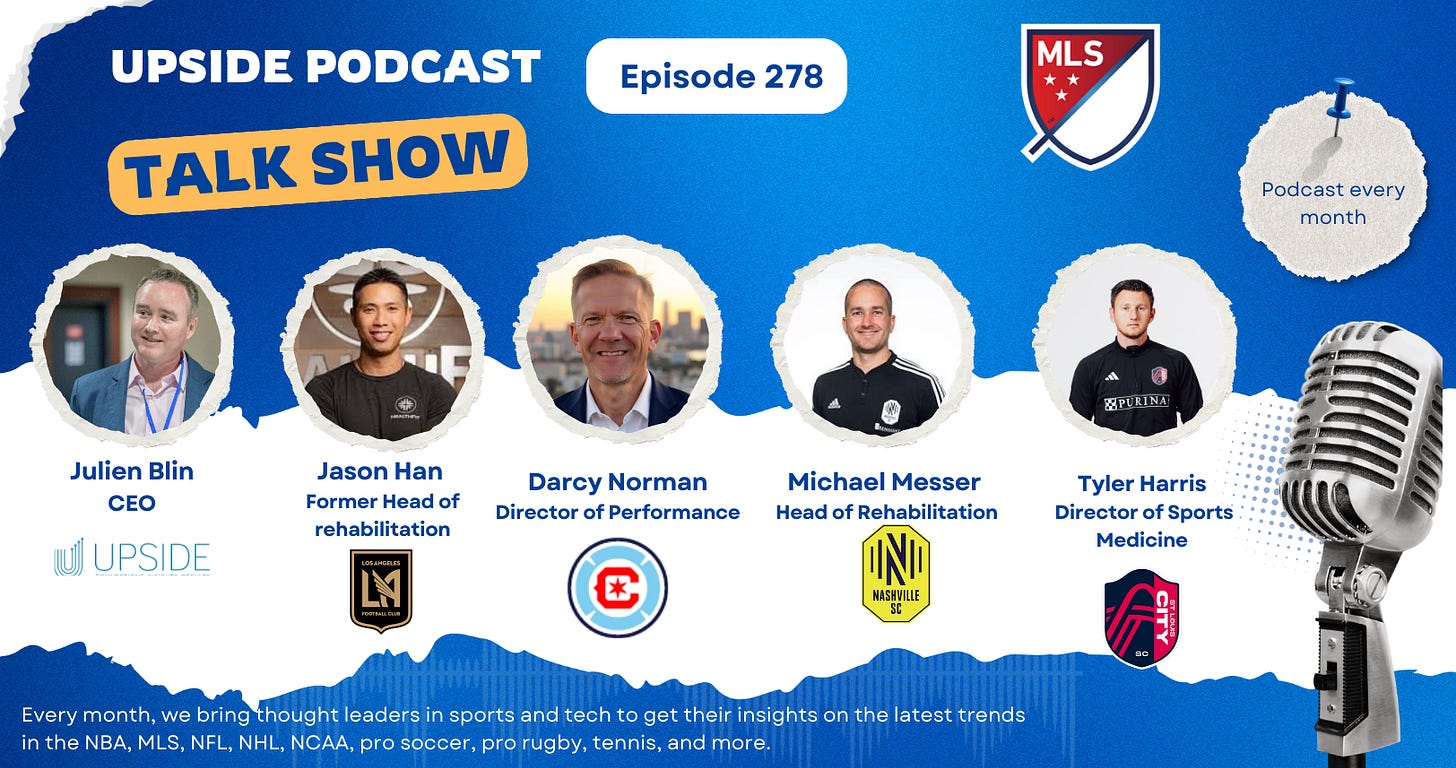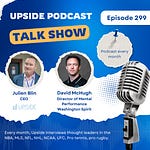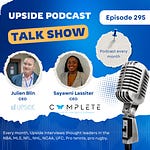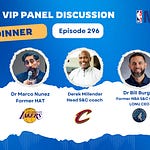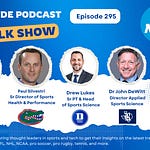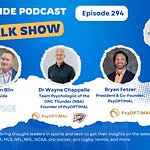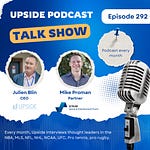This week we have the honor to interview again a group of sports performance executives to talk about the latest trends in the world of sports performance and rehabilitation.
Jason Han, the former head of rehabilitation at LAFC (MLS). Jason is also the head of business development in North America at OneBase health.
Michael Messer, the head of rehabilitation, Nashville SC (MLS).
Tyler Harris, the director of sports medicine, St Louis CITY SC (MLS).
Darcy Norman, the director of performance, Chicago Fire FC (MLS).
You can watch the video interview below by clicking on the Youtube link. You can also listen to the audio interview by clicking on the link at the top of the page:
📝Show Notes: Through this interview, we touched on:
Team Culture & Cohesion
“How are MLS teams evolving their approaches to building strong locker room culture—especially with diverse international rosters—and what practices have you seen work best to maintain unity throughout a long season?”Leadership Development
“What strategies are being used to develop leadership skills not just in captains or veterans, but across the roster so younger players also step into leadership roles?”Dealing with Adversity
“Adversity—whether it’s losing streaks, high-pressure games, or off-field distractions—comes with the territory. How do MLS teams build mental resilience and help players bounce back quickly?”Performance Tech & Vagus Nerve Stimulation:
“One of the latest trends in performance technology is the use of vagus nerve stimulators to help reduce anxiety, regulate HRV and blood pressure, and improve sleep. What are your thoughts on this technology, and how do you see it being applicable or valuable within MLS environments?”Generative AI & Team Strategy
“Generative AI (Open AI, Google Gemini.. is starting to impact clubs across many areas—operations, marketing, player performance, injury reduction, even fan engagement and customer service. Has your club begun implementing a Gen AI strategy, and where do you see the biggest opportunities or challenges for MLS teams?”
You can read the full transcript of the podcast interview located at the top of this blog post.
You can leave a comment by clicking on the button below:
Here are some of the best quotes of our conversation with Michael, Tyler, Darcy, and Jason:
Q1. Team Culture & Cohesion
“It really starts with having a clear vision of the club from the top down—with clear missions across departments and values that everyone has agreed upon. When people at every level know the standards, they can hold each other accountable and live by those values, not just talk about them. The clubs I’ve seen stay strong over time aren’t the ones built around one star or one season; they’re the ones that build an ethos that survives player turnover, staff changes, and the natural ups and downs of results. Culture is only real if it’s sustainable, and that comes from clarity, consistency, and accountability.” – Darcy Norman
“A team, at the end of the day, is like a business—you need systems in place to make sure people are aligned and onboarded quickly. That applies whether it’s a star signing arriving midseason or a role player joining the roster. At LAFC, for example, there were times when the medical staff was overwhelmed with injuries and new players were coming in, and you could lose track of the basics. Who shows them where the locker room is? Who explains recovery routines? When you have good systems, none of that slips. You can plug new people into the culture, and it continues to function without starting over.” – Jason Han
“One of the biggest shifts I’ve seen is the effort to make sure international players truly understand what the culture is—not just hearing it but actually feeling part of it. That means translating communication, making signage available in their first language, and ensuring expectations are crystal clear. If players can’t understand what’s being asked of them, they can’t buy in. It sounds simple, but those small steps make a huge difference in building unity across a diverse roster.” – Mike Messer
“Culture has to outlast individuals. Players will move on, staff members will come and go, but if you’ve built something aligned from the top down, then the ethos of the club endures. What matters is not just setting goals at the start of the season, but having processes in place that carry people through the grind of a long year. Culture is about alignment—getting everyone moving in the same direction, even when the daily grind threatens to wear people down.” – Tyler Harris
Q2. Leadership Development
“Younger players don’t always see themselves as leaders, but they are in their own way. They look up to staff and veterans almost like big brothers or father figures, and those day-to-day conversations in the training room matter. They see the guys who do the right things—not just the ones who get by on talent—and it sinks in. The message we try to get across is: football is important, but there’s more to it. You won’t be the young guy forever, so you need to mature faster and start leading yourself now, because in a year or two it’ll be your turn to set the standard.” – Jason Han
“Rehab can serve as a reset for younger players. It gives them space to observe what it really means to be a professional—how to build habits, how to take care of their bodies, and how to come back stronger, not just back to baseline. That’s where leadership starts for them: by learning how to manage themselves. And increasingly, clubs are recognizing the need to connect leadership development across the whole pathway—from academy to second team to first team—so it’s not just one-off moments but a consistent evolution.” – Mike Messer
“We’ve built leadership councils to make sure decisions reflect the whole group, not just the veterans. Six players are voted in by their teammates, representing different ages, backgrounds, and nationalities, so that the conversations reflect the full locker room. The council meets with staff, coaches, and sometimes management, which creates open dialogue and makes it truly a player-led environment. Everyone still has to lead themselves day to day, but the council formalizes the idea that leadership is distributed, not just for captains.” – Darcy Norman
“A big challenge for academy players stepping up is that they’ve often been the star in their youth environment, and suddenly they’re no longer the top dog. That can really shake their confidence. We rely heavily on mental performance coaches—whether in small groups or one-on-one sessions—to help those players develop the resilience and self-belief to keep growing. Leadership for them is about learning to carry that confidence into the next level, even when they’re not the star anymore.” – Tyler Harris
Q3. Dealing with Adversity
“That’s why you establish mission, vision, and values at the start of the year—because when adversity comes, those are the anchor points. You can go back and ask: are we living up to what we said we’d do? Are we sticking to the processes we agreed on? Adversity is never easy, but if you have that foundation, you can regroup and refocus without it turning into finger-pointing or panic. In MLS, you’re always going to have ups and downs, but if the structures are there, you can ride them out and keep the group together.” – Darcy Norman
“Sometimes adversity isn’t about grinding harder—it’s about taking a reset. That might mean time away from football, a team outing, or just giving players the mental space to recharge. Over a long season, you need those breaks, whether for individuals or the group. Otherwise, the weight of losses, injuries, or off-field distractions can snowball. The teams that manage adversity best are the ones that know when to step back, reset, and then return to the process.” – Tyler Harris
“The best way to handle adversity is to balance emotion with objectivity. Emotion can fuel you, but if you stay in it too long, it clouds your judgment. Football is an emotional sport, and players feel things deeply. Our job as staff is to stay calm, stay objective, and help them reset. Some of the best players I’ve worked with—like Carlos Vela at LAFC—were misunderstood as being detached, when in reality they just knew how to block things out and stay focused. That ability to reset quickly is what separates those who survive adversity from those who drown in it.” – Jason Han
“If everything is framed around your identity as a team, then the results, whether wins or losses, don’t shake you as much. You keep moving toward the bigger picture, and that consistency builds belief. Adversity is inevitable, but when the identity is strong, players and staff can look past the noise and stay focused on what actually matters.” – Mike Messer
Q4. Performance Tech & Vagus Nerve Stimulation
“I’ve experimented with devices like Apollo Neuro and Sensate myself before ever putting them on players, because if I don’t feel the effects, I can’t expect them to. Personally, I found some improvements in relaxation and recovery when I used them during meditation. With players, the context matters. In a noisy training room, it’s hard to get that effect. But on long flights or for individuals struggling with sleep or anxiety, it might be a tool that helps. I’m not convinced it’s an everyday solution, but for the right use case, it has value.” – Jason Han
“The bigger question is: why do you need it in the first place? If players are anxious or struggling with recovery, maybe the root issue is lifestyle, environment, or workload. Sometimes technology adds another layer of compensation without addressing the cause. That’s not to dismiss vagus nerve stimulation—it clearly has a physiological impact—but as practitioners we need to ask whether the real solution is deeper than a device. Otherwise, you risk treating symptoms instead of solving problems.” – Darcy Norman
“We’ve had good anecdotal results with the Neubie system, part of the NeuFit platform. It has a parasympathetic setting we’ll use when players show poor recovery or early signs of illness. Just a 15–20 minute session over a couple days has helped restore sleep and aid recovery. We’ve especially used it during tough travel stretches across time zones. It’s not a magic bullet, but if players come in after a rough trip and we can get them sleeping better quickly, that makes a big difference in their readiness.” – Tyler Harris
Q5. Generative AI & Team Strategy
“I’ll admit I was skeptical at first—I even said on a previous podcast I needed an AI 101 class. But recently I used ChatGPT to build a rehab protocol for an unusual injury, and it gave me a really solid framework to start from. It wasn’t perfect, but it saved me hours of searching and gave me references I could double-check. For me, that was the moment where I realized this can be a practical tool in sports medicine if you know how to ask specific questions.” – Mike Messer
“The potential game-changer is predictive modeling. If we can feed in baseline data at the start of the season and build risk profiles that we can monitor throughout the year, AI could help us anticipate injury risk before it becomes reality. It has to be paired with clinical expertise and real knowledge of the players, but as a tool, it could transform how we manage performance and health.” – Tyler Harris
“We use AI as a sounding board. It helps us brainstorm, process large amounts of information, and even critically evaluate our own protocols. We’ll put in a procedure and ask it to stress-test it—what would a lawyer, a coach, or a scientist say about this? That kind of critical feedback makes us sharper. At the end of the day, AI doesn’t make the decision for us, but it challenges our thinking in ways that are incredibly useful.” – Darcy Norman
“I use it every day, sometimes even in the sauna with the voice feature. I’ll literally have a 30-minute conversation with ChatGPT about an athlete case or a business problem. It doesn’t give me the final answer, but it makes me think differently, and it raises questions I might not have asked otherwise. That’s its real power. It’s not replacing us—it’s expanding our perspective and forcing us to execute better.” – Jason Han
You may also like:


